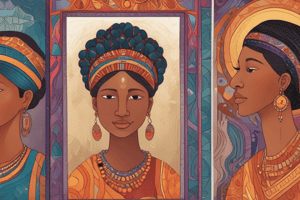Podcast
Questions and Answers
Which of the following is NOT a way to increase cultural competence?
Which of the following is NOT a way to increase cultural competence?
- Working effectively and respectfully with diverse people
- Making assumptions based on biases (correct)
- Developing knowledge, skills, and attitudes
- Reducing the number of assumptions made about people
What is the main goal of increasing cultural competence?
What is the main goal of increasing cultural competence?
- Becoming experts in cultures different from our own
- Developing strategies of accessibility and effective interventions
- Reducing ethnic and racial disparities for patients
- Increasing patient satisfaction, experience, and health outcomes (correct)
Which of the following is NOT a benefit of cultural competence?
Which of the following is NOT a benefit of cultural competence?
- Reducing ethnic and racial disparities for patients
- Developing strategies of accessibility and effective interventions
- Increasing patient satisfaction, experience, and health outcomes
- Becoming experts in cultures different from our own (correct)
What does cultural competence require us to do?
What does cultural competence require us to do?
Which of the following is NOT a component of culture?
Which of the following is NOT a component of culture?
What is the primary means of transmitting culture?
What is the primary means of transmitting culture?
How is culture learned by each generation?
How is culture learned by each generation?
Flashcards are hidden until you start studying
Study Notes
Cultural Competence
- Increasing cultural competence involves becoming aware of one's own cultural biases and embracing diversity.
- Main goal is to improve interactions and understanding across different cultures, enhancing collaboration and empathy.
- Benefits include improved communication, stronger relationships, and better service delivery in diverse environments.
Components of Culture
- Cultural competence requires continuous learning, openness to new ideas, and adapting to different cultural perspectives.
- Components of culture include beliefs, values, norms, and practices; attention to language, customs, and traditions is also vital.
- A primary means of transmitting culture is through communication, sharing experiences, and storytelling across generations.
Learning Culture
- Culture is learned through socialization, where individuals acquire cultural knowledge and practices from family, peers, and society.
- Each generation learns culture by observing, mimicking, and engaging with their environment, ensuring continuity and adaptation of cultural elements.
Studying That Suits You
Use AI to generate personalized quizzes and flashcards to suit your learning preferences.




